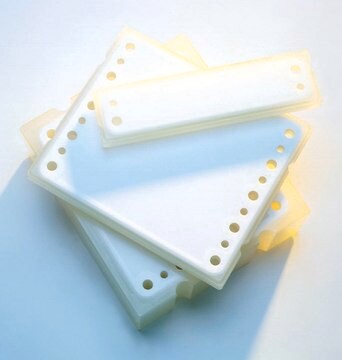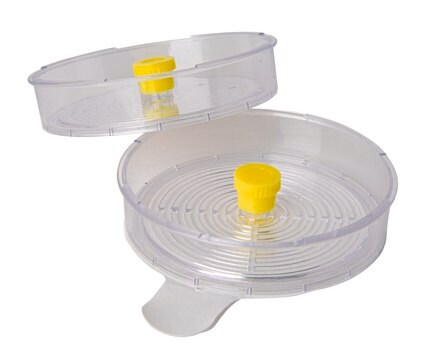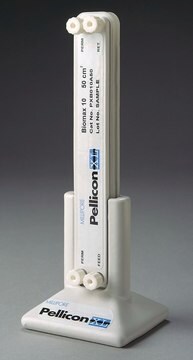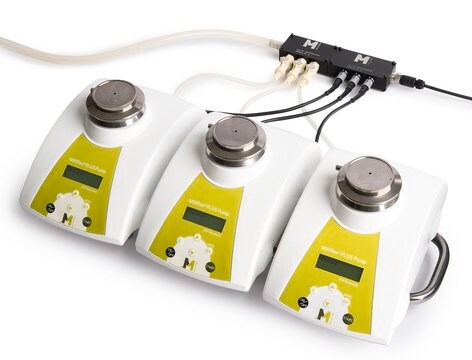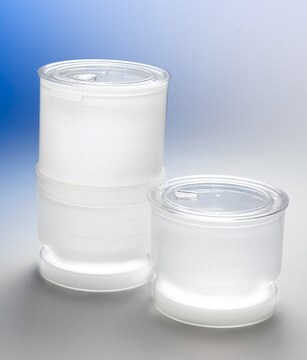P2B100C01
Pellicon® 2 Mini Ultrafiltration Biomax® Module
filtration area 0.1 m2, NMWCO 100 kDa
Synonym(s):
Pellicon® 2 Mini Ultrafiltration Module Biomax-100 C 0.1 m2
About This Item
Recommended Products
material
polyethersulfone
polypropylene screen
polyurethane adhesive
Quality Level
manufacturer/tradename
Pellicon®
parameter
0.33 bar max. transmembrane pressure (5 psig) (reverse)
5-35 L/min recirculation rate at 0.4 bar (6 psi)
7 bar max. transmembrane pressure (100 psig) at 30 °C (forward)
technique(s)
analytical sample preparation: suitable
protein purification: suitable
H
1.5 cm (0.6 in.)
L
21 cm (8.3 in.)
W
5.6 cm (2.2 in.)
filtration area
0.1 m2
membrane nominal area
0.1 m2
gravimetric extractables
≤1500 mg/m2
matrix
Biomax®
pore size
100 kDa NMWCO
pH
1-14
Looking for similar products? Visit Product Comparison Guide
General description
Millipore′s BIOMAX 100 polyethersulfone membrane has void-free structures that guard against leakage of solutes through microdefects normally associated with voids beneath the thin skins of conventional UF membranes. These void-free membranes are more permeable, resulting in high-flux with equivalent or superior product retention. These void-free membranes provide the advantages of fast, high yield processing and smaller systems.
The Pellicon® 2 Mini Ultrafiltration BIOMAX Module feature a filtration area of 0.1 m2 with a pore size of 100 kDa NMWCO.
Application
- Protein solutions
- Polysaccharide solutions
- Virus suspensions
Harvest, washing or clarification of:
- Cell cultures and lysates
- Colloidal suspensions
- Viral cultures
Features and Benefits
- Type C screen (coarse screen)
- Leading-edge void- free membranes to match virtually any separation challenge
- Short flow path for higher flux and higher resolution separation capability
- Choice of flow channel configuration providing process optimization capability
- Predictable, fast, scale-up
- True linear scalability from laboratory size modules to industrial assemblies for processing thousands of liters
- Brings higher resolution, improved yields and superior back-pressure resistance
- Ultracel membranes are composite membranes cast on a microporous substrate for defect-free membranes with superior
Other Notes
Analysis Note
Legal Information
Storage Class Code
10 - Combustible liquids
WGK
WGK 2
Regulatory Listings
Regulatory Listings are mainly provided for chemical products. Only limited information can be provided here for non-chemical products. No entry means none of the components are listed. It is the user’s obligation to ensure the safe and legal use of the product.
ISHL Notified Names
Substances Subject to be Notified Names
JAN Code
P2B100C01:
Certificates of Analysis (COA)
Search for Certificates of Analysis (COA) by entering the products Lot/Batch Number. Lot and Batch Numbers can be found on a product’s label following the words ‘Lot’ or ‘Batch’.
Already Own This Product?
Find documentation for the products that you have recently purchased in the Document Library.
Related Content
A relatively templated manufacturing process can be used to produce live vector vaccines. Challenges exist, however, and include yield loss due to sterile filtration, vector aggregation and scaling adherent cultures. Learn all about this core platform technology and how expertise—empowered by collaboration— can overcome manufacturing challenges.
Manufacturing viral vaccines is complex and there is no templated approach. Each process must be tailored to the shape, size, nature, physico-chemical behavior, stability, and host specificity of the virus. Learn all about this core platform technology and how expertise—empowered by collaboration— can overcome manufacturing challenges.
Our team of scientists has experience in all areas of research including Life Science, Material Science, Chemical Synthesis, Chromatography, Analytical and many others.
Contact Technical Service

